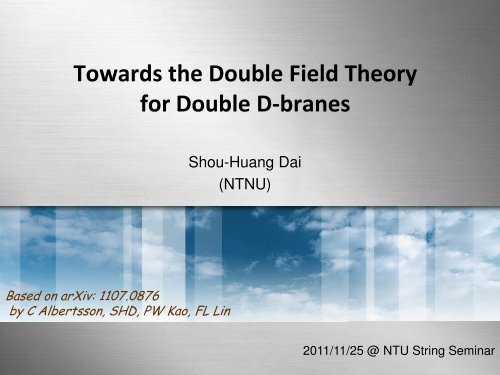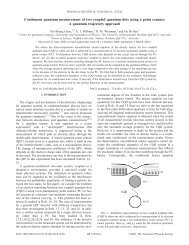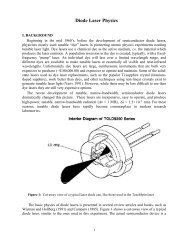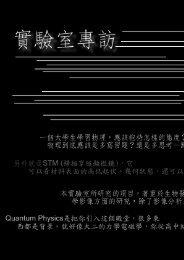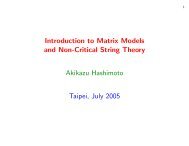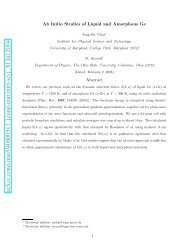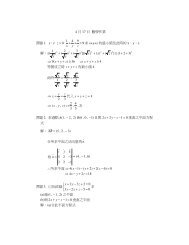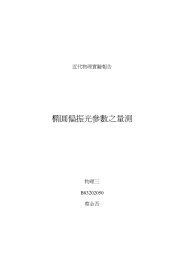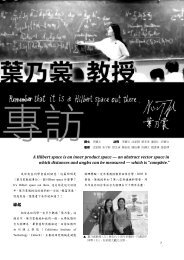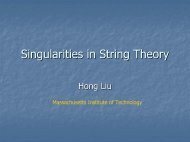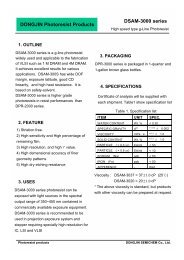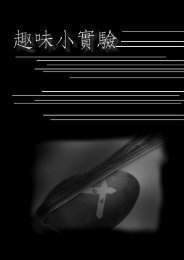pdf Dai
pdf Dai
pdf Dai
- No tags were found...
Create successful ePaper yourself
Turn your PDF publications into a flip-book with our unique Google optimized e-Paper software.
Towards the Double Field Theoryfor Double D-branesShou-Huang <strong>Dai</strong>(NTNU)Based on arXiv: 1107.0876by C Albertsson, SHD, PW Kao, FL Lin2011/11/25 @ NTU String Seminar
“Double“ means the string coordinates and their T-dualized ones are bothincluded in the background grometry. The background becomes a“doubled space“. T-duality (or, O(n,n) transformation) is realized as a symmetry. Goal: to derive the O(n,n) invariant effective action for the D-brane in thedoubled formalism.Here comes your footer Page 2
Outline of this talk Introduction Doubled formalism of string worldsheet action, and double D-branes Effective action for the Double D-branes Discussion, and open issuesHere comes your footer Page 3
Introduction Dualities relate different theories:- AdS/CFT: gravity QFT- S-duality: strongly weakly coupled theories- T-duality: IIA string theory on a circle with radius RIIB string theory on a dual circle with radius 1/R Question: Is it possible to construct a unified theory under a duality? For T-duality, such a theory implies, at very fundamental level, thespacetime may not be treated as fundamental constituents.Here comes your footerPage 4
T-duality Important as it relates different types of string theories and their excitations. For closed strings, T-duality swaps the KK-momentum n i on a circle withradius R to the winding mode w i on the dual circle with radius 1/R. For open strings, T-duality swaps the Dirichlet/Neumann b.c. to Neumann/Dirichlet b.c. of the dual string. This can be seen more easily in B=0 case,where T-duality swaps −Xto ∂X~, and −Xto X~. Thus T-duality relates∂ τD-branes with different # of dimensions.σ∂ σ∂ τ The open string boundary gauge field A is dualized to D-brane position X(D-brane worldvolume Higgs) in the dual theory.Here comes your footerPage 5
X = (X L + X R )/2 as the string coordinate on a circle with radius RT-dualityX ~ = (X L - X R )/2 as the coordinate on the dual circle with radius 1/R. The theory which includes X and X ~ is under the chiral constraint suchthat X L is left-moving and X R is right-moving:dX L = *dX L ,dX R = -*dX Rso that the physical degrees of freedom are not doubled. It’s natural to consider vertex operators e kX L and e kX R in the string theory,therefore to include X and its dual X ~ . The first one to consider such theoryis Tseytlin (Nucl.Phys.B350 (1991) 395-440 & Phys. Lett. B242, 163, ’92).Here comes your footerPage 6
T-duality as O(n,n;Z) transformations[Giveon, hep-th/9401139 ] The Hamiltonian In the basis of (w i ,n i ), the Hamiltonian can be written asHere comes your footerPage 7
Taking into account both the L and R sectors, the moduli space fortoroidal compactifications is isomorphic to O(n,n;Z)/ O(n;Z) × O(n;Z),which preserves the “Lorentz length“ , for n i , w i ∈Z.But in general the “Euclidean length“ is not preserved. H is O(n,n) covariant: Equivalently, define the nonlinear action of h on a n× n matrix E=B+G:→ Buscher’s rule: mix G and BHere comes your footerPage 8
Examples of O(2,2;Z) transformations T-duality on a single cycle:R1,2→ R−11,2 Shift of B-field: B = B + NHere comes your footer Page 9
Geometric GL(n,Z) transformation of T n :where A is a 2x2 matrix with integer entries. This correspond to thebasis change on T n and doesn’t change the physics.Here comes your footer Page 10
Hull‘s doubled formalism Since T-duality mixes G and B, it generates non-geometric string theorybackground. As a result, the T-duality-patched background is locallygeometric but globally not. The effect is same as regarding T-duality as a transition function betweenpatches of the background manifold. This non-geometric background iscalled a T-fold.Here comes your footerPage 11
[hep-th/0211182, 0508133, 0602025] Toy example of T-fold:- Start with T 3 with H-flux: (x,y,z) ~ (x+1,y,z) ~ (x,y+1,z) ~ (x,y,z+1)- T-dualizing along x-direction yields a twisted T 3 :- T-dualizing along y-direction yields a characterized by a non-geometricQ-flux = N:i.e. the volume of T 2 shrinks as one moves along S 1 in z.Here comes your footerPage 12
Hull geometrizes the T-fold on the T n torus fibration over a base manifoldN by doubling the torus bundle to T 2n which contains the original torus andthe T-dualized one. → doubled geometry G and B are represented geometrically by a “generalized metric”, and thusbecome part of the doubled geometry. The O(n,n;Z) transition functions between patches in the base space N isalso the diffeomorphism of the T 2n fibre. A self-duality constraint is imposed to eliminate half of d.o.f.’s and reduceto the physical space.Here comes your footerPage 13
Double field string worldsheet model [Hull, hep-th/0406102, 0605149] H is a 2n x 2n, symmetric “generalized metric“; X is a 2n-dimensional vectorwhose components parameterize a T 2n fibred over N. the double torusT 2n contains the original n-torus with coordinates andthe dual n-torus with coordinates . invariant under O(n,n;Z) ⊂ GL(2n):for h ∈ O(n,n;Z)(i.e. Invariant under T-duality transformation ⊂ diffeomorphism of T 2n )Here comes your footerPage 14
One can define a natural O(n,n;Z) invariant metric L IJ on the T 2n fibre: Impose self-duality constraint at the on-shell level to eliminate half of d.o.f.self-duality constraint: chiral constraint, half of the d.o.f.’s are left-movingwhile the other half are right-moving. GL(2n) broken to O(n,n;Z) due to L IJ . manifest worldsheet Lorentz symmetryHere comes your footerPage 15
Choose a polarization (i.e. a local choice of the physical subspace T n ⊂ T 2n )such that:This is equivalent to picking out a GL(n) ⊂ O(n,n) and breaks O(n,n) downto GL(n) × GL(n). After choosing a polarization and imposing the self-duality condition, theO(n,n) transformation reduces to the standard Buscher’s rule.Here comes your footerPage 16
In fact, Tseytlin already found the expressions for L and H in his pioneeringwork (Nucl. Phys. B350, 395, ’91 & Phys. Lett. B242, 163, ’92) . Tseytlin considered a Floreanini-Jackiw action for the chiral scalars X & .This action doesn‘t have manifest worldsheet Lorence symmetry. Byrequring on-shell Lorentz invriance, Tseytlin found the explicit expression forL, H, and the condition:X ~Here comes your footer Page 17
Dp-branes in string theory (conventional) a p-dimensional object to which the end pointsof the open strings attach.NDOpenString(part) Defined by the open string boundary conditions∂ X µ= 0σ (Neumann)σ =0µδX 0 or ∂ µ= 0 (Dirichlet)=0σ =0 =τXσD-brane The D-brane worldvolume effective action for the massless sector is theDBI action:SDBI~µ νab a b µν∫p+1 −Φd ξ e − det( Gab+ Bab+ 2πα' Fab)µ νBab= ∂aX ∂bX BµνG= ∂X∂XGHere comes your footerPage 18
D-branes in double field theory (Double D-branes)[Hull, hep-th/0406102][Lawrence et al., hep-th/0605149] Defined by O(n,n) covariant projectors Π N and Π D on the worldsheetboundary: From the boundary term of double field worldsheet action variationarises the boundary conditions(Neumann)(SD constraint)(Dirichlet)Here comes your footerPage 19
This implies Π N and Π D each projects out n-dimensions out of 2n-dimensionaldouble space. The double D-brane is an n-dimensional object in the 2n-dimensional doubledspace. The conventional sense of a Dp-brane is in fact the p-dimensionalintersection of the double D-brane with the physical T n ⊂ T 2n . “T-dualizing a Dp-brane” is to change the orientation of the double D-brane inthe double space by O(n,n) rotation.Here comes your footerPage 20
Conditions for the projectors Projector condition: Null conditions: b.c should be compatible with the self-duality constraint Can also impose the orthogonality conditioni.e. the Neumann direction can be completely specified by N-b.c.Here comes your footerPage 21
Comments D-brane configurations are specified by Π N (or equiv. Π D ), by solving thoseconditions. The boundary conditions specified by Π N and Π D describe a T-dualized D-brane pair. There are many solutions (i.e. D-brane configurations) whose physicalinterpretations are subtle. Orthogonality is imposed for physical reasons. It simplifies the calculation,but also excludes some simple configuration such as {D2 / D0} pair withnon-vanishing B-field.Here comes your footerPage 22
Examples: n=2 case D-brane pairD0-D2 pair: Consider the Dirichlet projectorwhich gives rise to the Neumann b.c.after imposing the self-duality constraint the b.c. becomes(D0-brane in {X,Y})or (D2-brane in{~X ,YY~})~One can T-dualize {X,Y} and { X , Y~ } s.t. the D2 in physical space is producedbySimilar case for the D1-D1 pair.Here comes your footerPage 23
Examples: n=2 projectorOne of the projectors satisfying all three conditions for B 0 is≠which implies the boundary condition in physical spaceThis is similar to the Neumann b.c. with B-field, but with an extra factor b 1 /(1-a 1 )enhancing B.Here comes your footerPage 24
What’s this D-brane configuration? Get back to the double space Dirichletcondition:The physical B-field projected from double space isb1B +1−a1= Double geometry properties + orientation of the double D-brane!Here comes your footerPage 25
Effective action of double D-branes The doubled theory is equivalent to the standard worldsheet theory at theon-shell level once the self-duality condition is imposed.[Tseytlin, Nucl. Phys. B350, 395, ’91 & Phys. Lett. B242, 163, ’92; Hull, hep-th/0406102 ] The equivalence hold also at the quantum level:the one-loop beta functions from the doubled worldsheet action of theclosed can be reduced to those from the standard worldsheet formalism.[Berman et al., 0708.2267] Alternatively, Hull and Zwiebach derive the closed string double field theoryfrom T-dual covariant closed sting field theory.[0904.4664, 0908.1792, 1003.5027,1006.4823]Here comes your footerPage 26
[1006.4823] Quick glance at Hull-Zwiebach‘s closed string double field theory:Action:with the strong constraint (from level matching condition):(i.e. all fields only depends on physical coordinates)Here comes your footerPage 27
This action is invariant underwhere [ , ] C is call the C-bracket, which does not satisfy Jacobi identity butsome specific Jacobiator relation.(C-bracket is an O(n,n) covariant extension of the Courant bracket fordoubled fields)[0908.1792] NB: Hull‘s double field worldsheet action is NOT invariant under δ ξ .Here comes your footerPage 28
We are going to quantize a chiral-constrained theory.It’s well-established by Pasti-Sorokin-Tonin (PST), by incorporating the self-duality condition into the action via Lagrange multipliers non-linearly, andintroducing new gauge symmetry (PST symmetry) to gauge away the nonchirald.o.f.’s. As a result, only the fields obeying the chiral constraint arephysical. The physical degrees of freedom are not doubled. 2 options to quantize the PST action:[PST, hep-th/9506109, 9509052, 9611100]Covariant: need to introduce ghosts to deal with the PST gauge symmetry.Non-covariant: gauge-fix the auxiliary fields but break manifest Lorentz symm.Floreanini-Jackiw (FJ) action[FJ, PRL59,1873,’87; Tseytlin‘91] We follow the non-covariant method.[Berman et al., 0708.2267]Here comes your footerPage 30
Our modelS FJS b we choose a very simple doubled geometry: the doubled flat space, withconstant G & B. In S b , A I contains gauge fields and their dual Higgs. But the Higgs are in theDirichlet directions and never contribute in the boundary action. However, the unwanted Higgs coupling can be removed after insertingand imposing the Dirichlet b.c. .Here comes your footerPage 31
The reduced notation for the extended Neumann Subspace The Neumann-projected quantities have no inverse in the full doublespace, but they do in the space projected out by Π N (i.e Neumannsubspace N) and T. It is convenient to introduce a reduced notation forboth the spatial and temporal Neumann directionswhere A p and X p denote the Neumann components of A Ithatand X I such The boundary action becomesHere comes your footerPage 32
The background field method:and work in Euclidean worldsheet signature for convenience. The background field expanded action:1 st order terms in ξ: e.o.m and b.c. for the background fields2 nd order terms in ξ: e.o.m and b.c. for ξ, and the boundary interaction termwherewhere F ab arise from A a = A a (X a ), orHere comes your footerPage 33
The boundary interaction term correspondsto the only one-loop graph contributing to theβ-function, and gives rise to the counter term The propagator satisfies[Callan et al., Nucl.Phys.B280,599,’87]e.o.m:b.c:Here comes your footerPage 34
The Neumann Green’s function solution is given bywhereThe result is of the same form as that for the conventional open stringworldsheet formalism, except that ours are double fields. Note that the inverse is taken within the extended Neumann subspace {X p ,T}.Here comes your footerPage 35
In the end, the equation of motion for the double D-brane is to demandvanishing β-function:which can be derived from a DBI-like action:by assuming that F ab also satisfy the Bianchi identity. Here the determinantabis taken within the extended Neumann subspace.Here comes your footerPage 36
Discussion and Open issues Manifest O(n,n) invariant master action is conjectured by recovering theN- and D-projectors while the orthogonality condition is imposed:where Vol n [Π D ] denotes the O(n, n) covariant volume of the space ofDirichlet projectors, and Reduction to non-double DBI:The double effective DBI-like action can be reduced to theconventional DBI when B=0, but not in the B ≠ 0 case.Here comes your footerPage 37
This may be due to that the B-field that appears in the doubled metricdoes not necessarily coincide with the B-field in physical space. Theeventual physical B-field after we project our theory down from thedoubled space is a combination of the doubled geometry properties (i.e.,the component B of the doubled metric) and the orientation of double D-branes.[0712.1026; 0806.1783; 0902.4032; 0904.0380] This may cause more complicated B-field dependence in the reducedaction from double formalism than the standard DBI.Here comes your footerPage 38
In the conventional worldsheet action, the boundary gauge transformationfor A is related to the bulk gauge transformation of B. But this is not clear inthe doubled formalism because O(n,n) mixes the gauge symmetry anddiffeomorphism.Here comes your footer Page 39
Thank YouHere comes your footer Page 40


